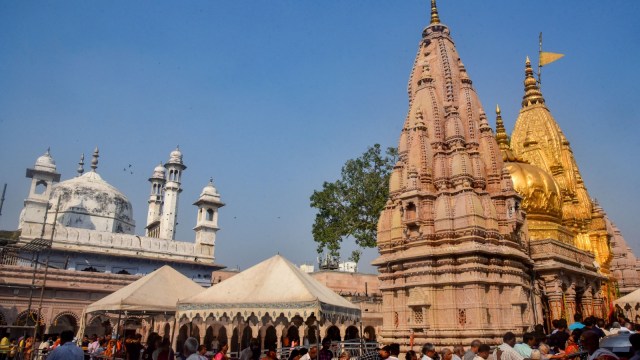After Varanasi court allows puja at Gyanvapi mosque complex southern cellar, DM says ‘order has been complied with’
A senior Varanasi police officer, present at the Gyanvapi mosque complex, said complete arrangements for security and maintaining law and order were in place.
 Varanasi: The Gyanvapi Mosque complex as seen from the Kashi Vishwanath Temple after the district court granted the family of a priest the right to worship Hindu deities in the Gyanvapi mosque cellar, in Varanasi, Wednesday, Jan. 31, 2024. (PTI Photo)
Varanasi: The Gyanvapi Mosque complex as seen from the Kashi Vishwanath Temple after the district court granted the family of a priest the right to worship Hindu deities in the Gyanvapi mosque cellar, in Varanasi, Wednesday, Jan. 31, 2024. (PTI Photo) Following the Varanasi court’s directive allowing a priest to conduct puja in the southern cellar of the Gyanvapi mosque complex and instructing the district magistrate to make necessary arrangements within seven days, DM S Rajalingam confirmed late on Wednesday they have followed the order.
However, Rajalingam did not provide specific details on the arrangements made.
On Wednesday evening, shortly after the court issued its order, Rajalingam, along with other government officials, entered the mosque complex through gate number 4 of the Kashi Corridor. The officials spent around two hours inside the complex. While leaving, the DM told the media present outside, “The court order has been complied with”.
When asked about the removal of barricading in front of the Vyas basement and whether the puja was conducted, the DM reiterated, “Whatever the court has said was complied with.”
A senior police officer present at the site told the media that complete arrangements for security and maintaining law and order were in place.
District Judge A K Vishvesha, in the order issued on Wednesday, directed, “District Magistrate, Varanasi/Receiver is being directed to get puja, raag bhog done by a priest, designated by the plaintiff and Kashi Vishwanath Trust, of idols in the cellar to the south, which is disputed, of the building situated on settlement plot no. 9130, police station Chowk, District Varanasi. For this, suitable arrangements must be made with iron barricading and other things within seven days.”
Late on Wednesday, S M Yasin, Joint Secretary of the Anjuman Intezamia Masajid Committee, which opposed the plea for allowing puja in the southern cellar, expressed concern. Yasin said, “The administration reached the mosque complex late evening. They cut the barricading towards the southern cellar. We were not informed about this, and we still haven’t received a copy of the court order. We will move the Supreme Court tomorrow”.
Appearing before the court, Hindu litigants have claimed the Gyanvapi mosque was built on the site of the earlier Kashi Vishwanath temple, which is next to it, after its destruction in the 17th century.
In its scientific survey report on the Gyanvapi mosque complex, the Archaeological Survey of India (ASI) said the “pre-existing structure appears to have been destroyed in the 17th century, during the reign of Aurangzeb and part of it was modified and reused in the existing structure”.
The ASI also said that “there existed a Hindu temple prior to the construction of the existing structure” at the site.







